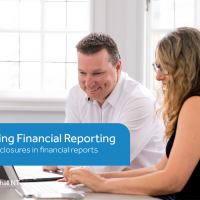Accounting standard changes
The good news is that only a handful of amended accounting standards will be applicable for the first time for entities with a 31 December 2017 year end. These include:
AASB 2016-1 Amendments to Australian Accounting Standards – Recognition of Deferred Tax Assets for Unrealised Losses [AASB 112]
This Standard amends AASB 112 Income Taxes to clarify the circumstances in which the recognition of deferred tax assets may arise in respect of unrealised losses on debt instruments measured at fair value.
AASB 2016-2 Amendments to Australian Accounting Standards – Disclosure Initiative: Amendments to AASB 107
This Standard amends AASB 107 Statement of Cash Flows to include additional disclosures and reconciliation relating to changes in liabilities arising from financing activities, including both changes arising from cash flows and noncash changes.
AASB 2016-4 Amendments to Australian Accounting Standards – Recoverable Amount of Non- Cash-Generating Specialised Assets of Not-for-Profit Entities
This removes the requirement for not-for-profit entities holding noncash-generating specialised assets at fair value to have to also assess recoverable amount. Not-for-profit entities holding such assets at cost will determine recoverable amount using current replacement cost defined AASB 13 Fair Value Measurement.
AASB 2017-2 Amendments to Australian Accounting Standards – Further Annual Improvements 2014–2016 Cycle
Removes the need for summarised financial information relating to a subsidiary, associate or joint venture where an entity’s interests in those entities are classified as held for sale, held for distribution to owners or discontinued operations in accordance with AASB 5.
Other than AASB 2016-2, we don’t expect that these changes will have a significant effect on most entities. The addition of new disclosures and reconciliation of changes in liabilities contained in AASB 2016-2 will require some attention at 31 December.
We have previously discussed these changes during our 2017 Financial Reporting Update seminars, details of which you can view on our website.
ACNC activities
Non-government schools submit financial questionnaires to the Department of Education and Training (DET) as a requirement under the Australian Education Act 2013 (Cth). To date, the ACNC has agreed to accept these financial questionnaires as meeting the financial reporting requirements under the ACNC Act. From 2017, DET will collect audited financial reports as part of FQ17 submissions and provide them to ACNC. The audited financial reports will be published on the ACNC Register.
From 1 January 2017, Prescribed Associations in South Australia that are registered with the ACNC no longer need to report annually to Consumer and Business Services SA (CBS). Instead, these charities will only need to report to the ACNC and comply with the ACNC’s regulatory requirements. The change will apply after the last financial year that the charity was prescribed – starting in the 2017 or 2018 financial year.
Where South Australian charities were previously required to provide financial reports to CBS because they were a prescribed association or holders of a Collections for Charitable Purposes Licence, the ACNC accepted those financial reports as meeting ACNC requirements. However, as a result of the changes, ACNC-registered South Australian charities that are medium or large will need to ensure that the financial reports they provide to the ACNC meet all the ACNC reporting requirements. Medium and large charities must prepare financial reports under
the Australian Accounting Standards that provide a true and fair view, report on an accrual basis and ensure statements include required comparative figures. To support charities whose reports do not currently meet these standards, the ACNC has established a two-year transitional reporting arrangement to assist charities adjust to their new reporting requirements. To find out more on these changes, visit CBS SA or the ACNC websites.
From 1 July 2017, charities registered with the Australian Charities and Not-for-profit Commission (ACNC) will no longer be required to also report to the ACT Government. Legislative changes passed in June 2017 means that those charities registered with the ACNC that undertake fundraising will no longer need a charitable collection licence in the ACT and will only need to submit their Annual Information Statement once,
to the ACNC.
A reminder that registered charities with a 30 June 2017 balance date have until 31 January 2018 to lodge their Annual Information Statement and, if necessary, their financial report with the ACNC.
What will 2018 bring?
The biggest changes facing entities from 1 January 2018 are the first time adoption of AASB 9 Financial Instruments and AASB 15 Revenue from Contracts with Customers.
AASB 9 contains new requirements for the classification and measurement of financial assets and incorporates amendments to the accounting for financial liabilities and hedge accounting.
Financial assets that are debt instruments will be classified based on: (1) the contractual cash flow characteristics of the financial asset; (2) the objective of the entity’s business model for managing those financial assets. All other financial assets will be classified as fair value through profit & loss, except where an irrevocable election is made to present fair value gains and losses on investments in equity instruments that are not held for trading in other comprehensive income.
Based on work we have done to date with our clients assessing the effects of adopting AASB 9, many financial assets are likely to reclassified from fair value through other comprehensive income to fair value through profit & loss, resulting in more volatility being reported in an entity’s operating profit.
For-profit entities will be applying AASB 15 for the first time from 1 January 2018, while not-for-profit entities don’t have to apply the new standard until 1 January 2019.
Clients should not underestimate the potential effects on the timing and measurement of revenue under the new standard. We are seeing changes effecting most industries including construction, manufacturing, software, telecommunications, resources and education. The not-for-profit sector also has to contend with the introduction of AASB 1058 Income of Not-for- Profit Entities from 1 January 2019.
How can Nexia Edwards Marshall NT help you?
We expect that 2018 will be a busy year as clients turn their attention to developing implementation plans and undertaking impact assessments of the new financial instruments (AASB 9) and revenue (AASB 15) standards, and that’s before we prepare for the new leases standard (AASB 16) in 2019. If you require any further information or assistance with assessing the effects of these changes, please contact Noel Clifford or your Nexia Edwards Marshall NT adviser.


